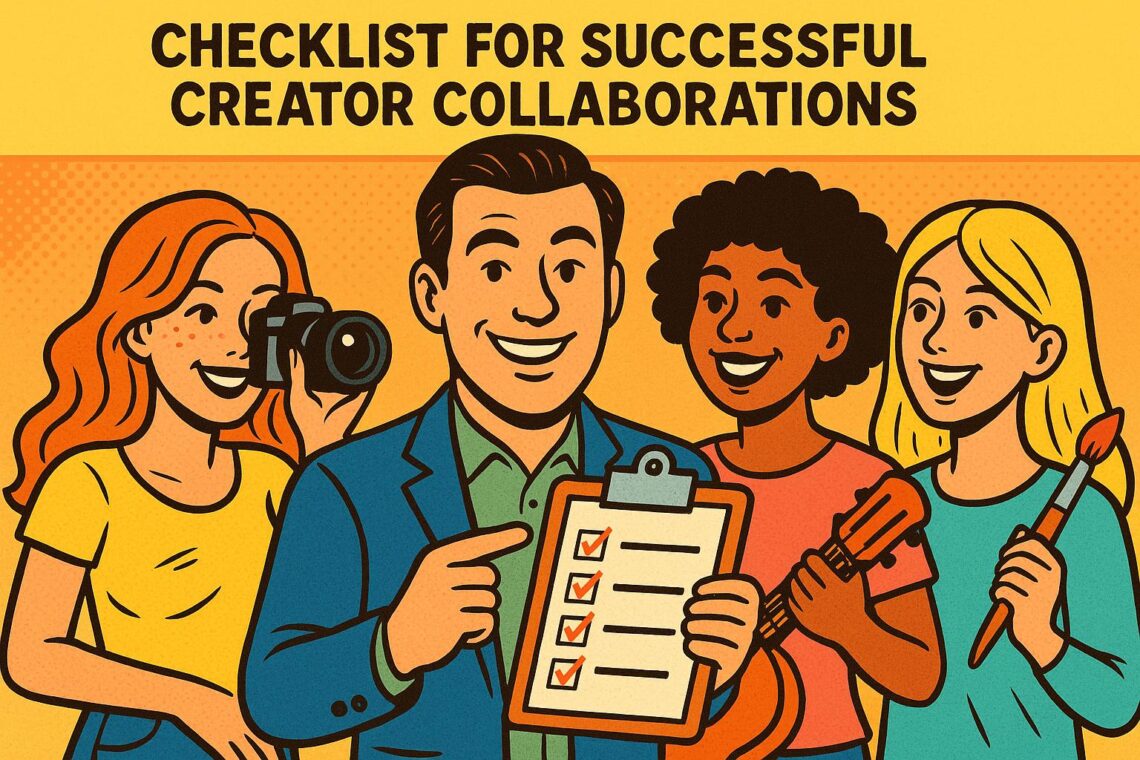Collaborating with creators can drive higher sales and expand your audience when done right. Nearly 90% of marketers find creator-led campaigns effective, with 60% reporting better results than traditional ads. Here’s how to ensure success:
- Choose the right creators: Focus on engagement rates and audience relevance over follower count. Tools like NimbusReach help identify creators with loyal, paying fans using metrics like the Fan Devotion Score.
- Set clear goals and agreements: Define objectives, content expectations, and payment terms upfront. Use contracts to outline rights, timelines, and revenue splits.
- Track performance: Monitor metrics like engagement, impressions, and revenue in real time. Advanced analytics tools can reveal deeper insights into campaign success.
- Maintain compliance: Follow FTC guidelines and platform rules to avoid penalties. Transparency and proper disclosures build trust.
- Build long-term partnerships: Work with creators who consistently deliver results and align with your brand for ongoing success.
How Do Brand Collaborations Work? 🤔 (10 Phases Start to Finish)
Finding the Right Creator Partners
The success of your collaboration depends heavily on choosing creators who not only align with your brand’s goals but also genuinely connect with your target audience through authentic fan engagement and proven outcomes.
Setting Compatibility Requirements
Before you start searching for creators, it’s crucial to define clear compatibility criteria. These guidelines will help you identify creators whose audience and values align with your brand for a partnership that feels natural and resonates with your customers. Look for creators whose followers closely match your target demographic in terms of age, interests, location, and purchasing habits. Their messaging should also reflect your brand’s ideals. It’s often better to work with a creator who has a smaller, highly relevant audience than one with a larger, less targeted following.
A 2024 survey revealed that 61% of marketers prioritize engagement rate over follower count when selecting creators, while only 18% focus primarily on follower numbers. This highlights the importance of looking beyond surface-level metrics.
Start by establishing clear criteria to ensure the creators you choose are a natural fit for your brand and audience.
Using Data-Driven Discovery Tools
Manually researching creators can be time-intensive and may leave out important performance indicators. Once you’ve set your compatibility standards, data-driven tools can streamline the process of identifying the right creators. Platforms like NimbusReach use advanced analytics to pinpoint creators with genuine, engaged audiences rather than relying solely on follower counts.
NimbusReach’s proprietary Fan Devotion Score evaluates multiple data points to measure how well a creator attracts paying fans.
"This isn’t just about follower count – it’s about genuine fan devotion and willingness to pay."
– NimbusReach
For instance, a Fan Devotion Score of 85.2 reflects strong engagement and audience interest. The platform also offers advanced filtering options, allowing you to search by niche, earnings data, and engagement rates. You’ll gain access to detailed analytics, including growth trends, audience demographics, and performance history. Brands using tools like NimbusReach often see a 30–50% boost in campaign ROI compared to those relying on manual selection methods.
Checking Creator Performance History
After narrowing down potential partners using compatibility and data insights, reviewing performance history provides a deeper layer of confidence. Focus on a creator’s growth trends over the past 6–12 months instead of just their follower count. Steady, organic growth is a good indicator of a loyal audience, while sudden spikes may suggest temporary or artificial boosts.
Engagement consistency is another critical factor. Micro-influencers with 10,000–100,000 followers, for example, often achieve engagement rates up to 60% higher than their macro-influencer counterparts, making them especially valuable for targeted campaigns.
Pay close attention to evidence of superfans – dedicated followers who frequently comment, share, and make purchases based on the creator’s recommendations. These superfans often drive the bulk of revenue in successful campaigns, with a small group of highly effective creators typically generating the most significant results.
Review past sponsored posts to see how the creator’s audience responded. Did engagement stay consistent, or did it drop during branded content? Creators who maintain audience trust while integrating brand messaging are invaluable.
Lastly, analyze how their content performs across various formats such as photos, videos, and stories. Consistently high-quality content that resonates with their audience is essential for maintaining engagement and ensuring long-term success.
Setting Up Clear Collaboration Agreements
Once you’ve chosen creators using data-driven tools, the next step is to establish formal agreements. These agreements clarify goals, protect both parties’ rights, and ensure a smooth collaboration process.
Defining Shared Goals and Limits
Setting clear objectives and boundaries is crucial to avoiding misunderstandings that could derail your campaign. For example, you might aim to generate 500 new subscribers within 30 days. Goals like this should be specific and measurable.
Your campaign brief should outline the type of content you expect, the intended audience, and the core messaging. It’s equally important to set content boundaries – this could include topics to avoid, language restrictions, or visual elements that don’t align with your brand values. Additionally, specify restrictions on brand asset usage, competitor mentions, and themes that conflict with your brand identity. According to industry reports, campaigns that use formal contracts and detailed briefs experience higher satisfaction rates and fewer disputes – over 70% of the time, in fact.
Once goals are defined, formal contracts can lock in financial terms and content rights.
Creating and Signing Contracts
Contracts are essential for legal clarity and to ensure everyone is on the same page regarding payments, content rights, and revenue sharing. Your agreement should clearly outline how earnings will be distributed – whether it’s a flat fee, a percentage of revenue, or performance-based compensation.
Include specifics like payment timelines (e.g., within 15 days of publication) and payment methods, as well as any associated fees. Make sure to note the currency (e.g., USD) to avoid confusion.
Content ownership and usage rights also need careful attention. Specify whether your brand can repurpose the content for use in other marketing channels and the duration of those rights. Include clauses addressing content modifications, takedown requests, and dispute resolution processes.
Revenue sharing should cover all potential streams, such as subscription fees, tips, pay-per-view messages, and custom content sales. Ensure there’s a clear system in place to track and divide earnings from each source.
When finalizing contracts, ensure they align with the specific policies of the platform you’re working on.
Following Platform Rules and Policies
Adhering to platform guidelines is critical to avoid account suspensions, content removals, or legal complications. Each platform has its own rules regarding promotional content, disclosure requirements, and monetization practices.
Before proceeding, confirm that the creators you’re working with have active accounts in good standing. Check for any recent policy violations or restrictions, as issues like shadow bans or suspensions can drastically reduce the reach of your content.
Platforms like OnlyFans and Instagram have distinct requirements. For instance, Instagram mandates clear disclosure of paid partnerships using hashtags such as #ad or #sponsored. OnlyFans, on the other hand, has specific rules for external link sharing and branded content.
If you’re collaborating on adult content, be especially mindful of legal requirements. U.S. laws, for example, mandate strict record-keeping and age verification for adult content. International collaborations may involve additional regulations, so ensure compliance with all applicable laws.
Agencies that use advanced tools for creator discovery and analytics report up to 40% higher ROI from campaigns, largely due to better creator selection and well-defined agreements[context].
Lastly, include provisions in your agreements for handling policy violations or account issues. Define how you’ll address situations like account restrictions, and establish backup communication channels to ensure the collaboration can continue uninterrupted.
Planning and Creating Joint Content
Once you’ve nailed down agreements and chosen the right creators, the next step is crafting a solid content plan that keeps your campaign on track and your audience engaged. A well-thought-out strategy can make all the difference in achieving your goals.
Building a Content Strategy
Start by setting clear, measurable goals that align with your broader marketing efforts. Create a concise brief that outlines the key messages, target audience, tone, platform-specific needs, and content formats. This roadmap ensures everyone is on the same page and working toward the same objectives.
Your strategy should focus on content that resonates with your audience while playing to each creator’s strengths. For example, if your campaign targets both tech-savvy younger audiences and professional adults, you might produce interactive, trendy content for the younger crowd and more in-depth, educational pieces for professionals. This tailored approach makes your audience feel seen and keeps them engaged.
While it’s important to provide clear direction, don’t forget to leave room for creators to bring their unique style and voice to the table. You can also suggest optional extras, like behind-the-scenes content, to add depth to the campaign without making it a requirement.
Once your strategy is set, establish clear timelines to keep everything moving smoothly.
Managing Schedules and Deadlines
Deadlines are the backbone of any successful campaign. Break the project into phases – kick-off, concept development, draft submissions, the launch itself, and final insights review – and assign specific deadlines to each. Make sure your timeline aligns with major events, product launches, or periods when your audience is most active.
To keep everyone on the same page, use shared calendars or tools like Google Calendar, Asana, or Trello. For U.S.-based campaigns, ensure all dates are formatted in MM/DD/YYYY for consistency.
It’s also smart to include buffer time for reviews and revisions. Being upfront about deadlines and compensation – whether it’s monetary, product exchanges, or affiliate commissions – helps avoid any confusion. Regular check-ins can address questions and offer support without micromanaging, striking a balance between structure and creative flexibility.
And don’t forget to have backup communication channels in place. If your primary platform goes down, this ensures the project stays on track without unnecessary delays.
Maximizing Engagement and Reach
To maximize engagement, focus on tailoring your content using deep audience insights and data-driven strategies. Audience segmentation is key – it allows you to create content that speaks directly to the needs and interests of specific groups.
Use analytics tools to monitor engagement, reach, and audience reactions. For instance, platforms like NimbusReach can evaluate a creator’s Fan Devotion Score, helping you identify collaborators with truly engaged audiences.
"This isn’t just about follower count – it’s about genuine fan devotion and willingness to pay."
– NimbusReach
Real-time insights can guide you in tweaking content for better performance. Collaborating with "Trending Creators" or "Breakout Creators" identified through growth prediction models is another way to tap into fast-growing, highly engaged audiences.
Finally, set SMART goals (Specific, Measurable, Achievable, Relevant, Time-bound) to track performance and adjust your strategy as needed throughout the campaign. This ensures your efforts stay aligned with your objectives and deliver the best possible results.
sbb-itb-bd3d2dc
Publishing and Tracking Collaboration Results
Once your campaign is live, the real work begins. Proper execution and tracking are what separate a lackluster collaboration from one that delivers tangible results. Launching content effectively and keeping an eye on the right metrics are critical steps to ensure your collaboration achieves its goals.
Launching Content Properly
Before hitting publish, make sure all platform-specific requirements are met. For example, OnlyFans mandates that everyone involved in collaborative content complete identity verification and consent forms prior to publishing. Skipping these steps can result in content removal or even account penalties, so double-check everything.
On Instagram, use the "Add Collaborator" feature to share ownership of posts, boost visibility, and ensure proper credit. Tagging creators accurately is key to maximizing reach and avoiding mistakes. Instead of just mentioning usernames in captions, use the platform’s built-in tools for better attribution. Don’t forget to include campaign hashtags and relevant handles in your captions to enhance discoverability.
It’s also a good idea to establish a content approval process in advance. This ensures all content aligns with your campaign goals and meets quality expectations before it goes live.
Monitoring Metrics and Engagement
Tracking the right metrics is crucial to understanding how your campaign is performing. Keep an eye on data like impressions, engagement, follower growth, click-through rates, and revenue. While most platforms provide built-in analytics, tools like NimbusReach offer deeper insights, such as audience engagement trends, growth patterns, and even a proprietary Fan Devotion Score. These advanced metrics can help you identify which collaborations bring in loyal, paying fans.
Setting up shared dashboards allows all collaborators to monitor performance in real time. Regular check-ins are essential to review results, address any issues, and fine-tune your strategy. Successful campaigns often see significant boosts in reach, engagement, and revenue. Watching for spikes in engagement and understanding what caused them can offer valuable lessons for future campaigns.
Managing Revenue Distribution
Transparency in revenue tracking is just as important as monitoring performance metrics. Agree on revenue splits before the campaign begins and use automated tools to track earnings. Payments should be documented in USD, with clear schedules to avoid misunderstandings.
Whenever possible, rely on native tracking features for accurate revenue attribution, especially for subscription-based platforms. For more complex financial arrangements, third-party payment processors or escrow services can provide added security and accountability.
If disputes arise, refer back to the signed contract. A well-drafted agreement should outline revenue splits, payment timelines, and a process for resolving disputes. To keep things organized, consider using a simple spreadsheet to track total earnings, each creator’s share, payment dates, and any deductions like platform fees. This not only ensures transparency but also simplifies tax reporting.
Payment timing is another factor to consider. Some creators prefer weekly payouts, while others are fine with monthly distributions. Using clear, US-standard documentation for all agreements and payments helps maintain professionalism and minimizes confusion about schedules and amounts.
Analyzing and Improving Collaboration Methods
The success of any collaboration is reflected not just in immediate results but also in the insights it generates for future campaigns. By systematically analyzing outcomes and gathering feedback, each partnership becomes a stepping stone toward long-term growth. Agencies that prioritize continuous improvement set themselves apart, turning average campaigns into consistently profitable ones.
Reviewing Performance Data
To measure the impact of a collaboration, focus on metrics that reveal how well it connects with the audience and its revenue potential. Key indicators include engagement rates, conversion rates from free to paying users, and average revenue per user (ARPU). These numbers provide a clearer picture of whether the collaboration delivered meaningful results.
Establish a standardized system for tracking performance, one that includes both raw metrics and adjusted figures. For example, calculating the cost per thousand impressions (CPM) allows for fair comparisons across creators of varying sizes and collaboration types. This approach ensures you’re assessing partnerships based on actual returns, not just vanity metrics.
Timing is another critical factor. Look for sustained growth rather than temporary spikes in performance; the former often signals a more impactful partnership. Additionally, monitor audience retention after the collaboration ends. Creators whose audiences remain engaged with your brand demonstrate a lasting influence that’s worth nurturing.
Comparing the results of a campaign against its initial goals and benchmarks from similar past efforts can reveal valuable insights. Document which content formats resonated most, the posting schedules that drove the highest engagement, and any shifts in audience demographics. Over time, these patterns will help refine your strategies.
For deeper insights, advanced analytics tools like NimbusReach can be invaluable. These platforms go beyond basic metrics, uncovering trends in audience engagement and growth that might otherwise be overlooked. They can also identify which collaborations attract loyal fans likely to become paying customers – a crucial insight, as a significant portion of revenue often comes from a small group of top-performing creators.
While data provides a solid foundation, pairing it with direct feedback from creators and audiences offers a more complete understanding.
Collecting Feedback for Better Results
Feedback can uncover nuances that raw data alone might miss. Aim to collect feedback from both creators and audiences about 1–2 weeks after a collaboration wraps up. Use a mix of numerical ratings and open-ended questions to gather insights about what worked and what didn’t.
Encourage creators to share candid thoughts by asking specific questions like, "What part of the creative brief was most helpful?" or "Where did you feel uncertain or need more guidance?" Reassure them that their feedback won’t negatively impact future opportunities – it’s purely to improve future collaborations.
Consider a multi-step feedback process. Start with forms to gather structured input, then follow up with informal video calls or phone conversations. These personal discussions often reveal insights that creators might hesitate to put in writing. If needed, use a neutral third party to conduct these sessions, as creators might feel more comfortable being honest with someone outside the immediate partnership.
Audience feedback is equally important. Analyze comments, conduct polls, and review direct messages to understand how the collaboration was received. Comparing creator feedback with audience reactions can highlight gaps between the intended message and how it was actually perceived, offering valuable lessons for future campaigns.
Organize all feedback in a centralized system, categorized by collaboration type, creator tier, and content format. Over time, recurring themes will emerge, guiding you toward strategies that consistently deliver results while flagging areas that need adjustment.
Maintaining Long-Term Partnerships
Building lasting relationships with creators can lead to higher trust, more consistent results, and even referrals to other top performers. Strengthen these partnerships by extending connections beyond single campaigns.
Set up a relationship management system to maintain regular communication. Monthly check-ins – whether through direct messages or emails – can keep the connection alive without being intrusive. Use these touchpoints to share industry insights or simply ask how the creator is doing. Recognizing their achievements publicly also goes a long way in solidifying the partnership.
Offer value between collaborations. This could include early access to new products, exclusive event invitations, or introductions to other creators and brands that align with their goals. Sharing performance data, market trends, or strategy tips positions you as a partner invested in their success, not just a client.
Focus your resources on nurturing relationships with creators who have demonstrated strong performance. Consider establishing a "preferred partner" program with benefits like priority access to campaigns, higher compensation, or more creative freedom. This approach ensures your efforts are concentrated on high-potential partnerships rather than being spread thin across average ones.
Finally, monitor the health of your relationships alongside performance metrics. Pay attention to how quickly creators respond, their enthusiasm for new opportunities, and the quality of their creative input over time. Strong partnerships often lead to creators proactively suggesting ideas or introducing you to other talented individuals in their network, creating a ripple effect of growth opportunities through trusted connections.
Key Points for Creator Collaboration Success
Nailing creator collaborations isn’t just about luck; it’s about blending strategic planning with genuine relationship-building. The right mix of fundamentals and tools can make all the difference.
Start with data-driven discovery to find creators who truly resonate with your goals and audience. Instead of zeroing in on follower counts or surface-level metrics, focus on creators with real engagement and loyal, paying fans. For example, NimbusReach uses advanced filters and its Fan Devotion Score to identify creators with active, revenue-generating audiences. Why does this matter? Because top-performing creators often bring in significantly more revenue compared to their mid-tier counterparts.
Set clear expectations right from the start by providing detailed briefs and transparent agreements. Research shows that clear, specific briefs can increase engagement rates by 30% compared to vague instructions. Your contracts should cover all the essentials, including legal compliance with FTC guidelines, to avoid misunderstandings and ensure both parties are protected throughout the partnership.
Encourage open communication and creative freedom to strike the perfect balance between brand guidelines and the creator’s unique voice. When creators are allowed to present your message in their own style, their audience is more likely to trust and engage with the content. Regular check-ins, paired with structured scheduling and feedback processes, help keep things on track without stifling the creator’s creativity.
Track performance metrics in real time to measure how the collaboration is performing and identify areas for improvement. Focus on meaningful metrics like engagement rates and revenue generation instead of vanity numbers. With 89% of marketers reporting that ROI from influencer marketing matches or exceeds other channels, tracking the right metrics ensures you’re capturing the full value of your investment.
Build long-term relationships with creators who consistently deliver results. These ongoing partnerships tend to yield better outcomes over time as creators grow more familiar with your brand. Plus, top-performing creators are often great connectors, referring other high-quality partners and expanding your network of successful collaborators.
FAQs
How can I make sure a creator’s audience matches my brand’s target demographic?
To make sure a creator’s audience aligns with your brand, pay attention to a few important factors: their niche, engagement rate, and audience demographics. The goal is to find creators whose content naturally reflects your brand’s values and connects with the audience you want to reach.
Leverage tools that offer detailed analytics and filtering options to pinpoint creators with authentic, engaged followers who fit your ideal customer profile. Focus on those with strong engagement and a history of building genuine connections with their audience to get the most out of your partnership.
What should a collaboration contract include to ensure clarity and prevent disputes?
When putting together a collaboration contract, it’s crucial to cover the basics clearly. Start by detailing the scope of work, the expected deliverables, agreed-upon timelines, and payment terms. These elements set the foundation for a shared understanding between all parties.
Make sure to spell out the responsibilities of each party, who owns the intellectual property, and the rules for content usage. This helps prevent any confusion or disputes down the road.
To add an extra layer of security, include clauses for dispute resolution and the conditions under which the agreement can be terminated. By addressing these points from the outset, you can help ensure a smoother working relationship and reduce the risk of conflicts.
What’s the best way to monitor the success of a creator collaboration campaign in real time?
To keep tabs on how your creator collaboration campaign is performing in real time, use tools that offer in-depth analytics and performance tracking. Platforms like NimbusReach are a great option, allowing you to monitor critical metrics like audience engagement, growth patterns, and earnings. This helps you make smart, data-backed decisions as the campaign progresses.
Zero in on the metrics that align with your goals – whether that’s follower growth, engagement rates, or revenue. By keeping an eye on these numbers as they happen, you can tweak your strategies on the fly to get better results and ensure the collaboration achieves clear, measurable outcomes.





